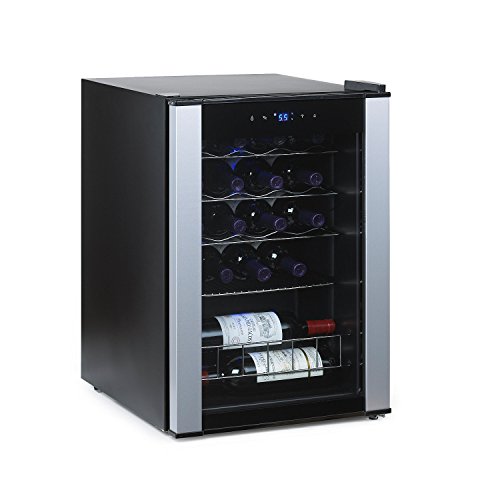In this step-by-step guide, we will walk you through the process of adjusting the temperature in a built-in wine fridge cabinet. Whether you want to ensure your wine is stored at the optimal temperature or need to make adjustments due to changing environmental conditions, this guide has got you covered.
Wine Coolers That Are Flying Off the Shelves
Locate the temperature control panel
To locate the temperature control panel in your built-in wine fridge cabinet, let’s start by checking inside the fridge. Open the fridge door and look for buttons or dials that are labeled with temperature indicators. These indicators should clearly display the desired temperature settings for your wine.
If you don’t find the temperature control panel inside the fridge, don’t worry! It might be located on the front panel of the cabinet. Take a look at the front of your wine fridge and search for buttons or dials that have temperature labels. These controls are usually placed conveniently on the front for easy access and adjustment.
Remember, the temperature control panel is crucial for maintaining the ideal conditions for your wine. By locating it, you’ll be able to adjust the temperature settings as needed, ensuring that your wine stays at its best.
Understanding the temperature settings
To understand the temperature settings of your wine fridge cabinet, let’s take a moment to familiarize ourselves with them. First, locate the temperature control panel on your wine fridge. It is usually located inside the cabinet, either on the top or the side. Once you’ve found it, make sure you know what the current settings are by checking the display or buttons on the control panel.
Next, it’s important to know what temperature range is suitable for your wine collection. Different types of wine require different storage conditions to maintain their quality and taste. Generally, the ideal temperature for most wines is between 45°F (7°C) and 65°F (18°C). However, specific wines may have different temperature requirements. For example, red wines are typically stored at slightly higher temperatures than white wines. Refer to the user manual or manufacturer’s guidelines to determine the recommended temperature range for your specific wine collection.
By familiarizing ourselves with the temperature settings of our wine fridge cabinet and understanding the suitable range for our wine collection, we can ensure that our wines are stored under optimal conditions. This will help preserve their flavors and aromas, allowing us to fully enjoy our favorite bottles. So, take a few moments to check the current settings and adjust them if needed, ensuring that our wine fridge provides the perfect environment for our cherished wines.
Adjusting the temperature
To adjust the temperature of your wine fridge, locate the temperature control panel first. Once you’ve found it and understand the settings, it’s time to make the adjustment. If your wine fridge has specific buttons for setting the temperature, use them to increase or decrease the temperature as desired. Alternatively, if your model requires a dial, simply turn it clockwise to decrease the temperature or counterclockwise to increase it. Remember to refer to the instructions provided with your specific model if you’re unsure about any steps.
Now that you know how to adjust the temperature, it’s important to keep in mind that different types of wine require different storage temperatures. Generally, white wines are best stored at cooler temperatures, usually around 45-50°F (7-10°C), while red wines are typically stored at slightly warmer temperatures, ranging from 50-65°F (10-18°C). However, it’s worth noting that these temperature ranges can vary depending on personal preference and the specific wine being stored. Experiment and find the temperature that suits your taste best. Cheers to perfectly chilled wines!
Monitoring the temperature
After adjusting the temperature, give the wine fridge cabinet some time to reach the new setting. Allow the cabinet to run for at least 24 hours before making any further adjustments. This will give the cooling system enough time to stabilize and reach the desired temperature. During this time, avoid opening the cabinet frequently as it can affect the cooling process and delay reaching the set temperature.
To monitor the temperature inside the cabinet, use a thermometer. Place the thermometer in an easily visible spot, such as on a shelf near the center of the cabinet. Make sure the thermometer is not in direct contact with any bottles or the cabinet walls, as this could affect the accuracy of the reading. Keep a close eye on the thermometer and check it regularly to ensure that the temperature remains steady within the desired range. If you notice any significant fluctuations, you may need to adjust the temperature settings accordingly.
Making further adjustments
If you find that the temperature of your fridge is not ideal or needs further adjustment, follow these steps to fine-tune the settings:
- Press the temperature control button to enter the settings menu.
- Use the arrow buttons to navigate to the temperature adjustment option.
- Press the temperature control button again to select the option.
- Use the arrow buttons to increase or decrease the temperature to your desired setting.
- Once you have made the adjustment, press the temperature control button to confirm the changes.
Remember to give the fridge cabinet enough time to stabilize after each adjustment. This ensures that the new temperature setting takes effect and allows the fridge to reach the desired temperature. It is recommended to wait at least 24 hours before making any further adjustments to allow the fridge to fully stabilize. Keep an eye on the temperature display and monitor the performance of your fridge to ensure it is maintaining the desired temperature.
Wrapping it all up
In conclusion, we have learned that adjusting the temperature in a built-in wine fridge cabinet is not as complicated as it may seem. By following the steps outlined in this blog post and familiarizing yourself with your specific model’s temperature settings, you can easily maintain the ideal temperature for storing and enjoying your wine. So, there’s no need to worry about your wine going bad or losing its flavor. With a little knowledge and a few simple adjustments, you can ensure that your wine is always kept at its best. Cheers to perfectly chilled wine!
Mastering Wine Storage
Setting Up Your SnoMaster VT41 46 Wine Cooler: A Step-by-Step Guide
Getting the most out of your built-in wine fridge cabinet
- Familiarize yourself with the controls: Take some time to understand the temperature settings and other controls on the wine fridge cabinet. This will allow you to customize the conditions to suit your specific needs
- Organize your bottles: Decide how you want to organize your wine bottles within the fridge cabinet. You can group them by varietal, region, or any other method that makes sense to you. This will help you locate specific bottles easily
- Set the ideal temperature: Depending on the type of wine you have, you’ll want to set the temperature accordingly. Red wines typically require a slightly warmer temperature (between 55-65°F) while whites and sparkling wines are best stored at cooler temperatures (around 45-55°F)
- Avoid frequent temperature changes: Wine prefers a stable environment, so try to minimize temperature fluctuations. Opening the door frequently or placing the wine fridge cabinet in an area with high temperature fluctuations can affect the quality of your wine
- Regularly clean and maintain: Clean the interior of the wine fridge cabinet periodically, removing any dust or debris that may have accumulated. Also, check the seals around the door to ensure they are free from any cracks or leaks
- Remember, these are just a few basic tips to get you started with using a built-in wine fridge cabinet. As you gain more experience and knowledge, you can further explore different techniques and practices that suit your preferences. Enjoy your wine!
Answers to all your burning questions about built-in wine fridge cabinets
Can a built-in wine fridge cabinet be installed in any room of the house?
Yes, a built-in wine fridge cabinet can generally be installed in any room of the house, as long as there is enough space and proper ventilation. It is important to consider factors such as electrical requirements, insulation, and the ability to maintain a consistent temperature. Additionally, some homeowners may prefer to install the wine fridge cabinet in specific rooms like the kitchen, dining area, or a dedicated wine cellar for easier access and aesthetic reasons. However, it ultimately depends on individual preferences and the suitability of the chosen location.
What are the advantages of having a built-in wine fridge cabinet?
Well, having a built-in wine fridge cabinet offers several advantages. First and foremost, it provides a dedicated space to store and display your wine collection. This can be especially beneficial if you are a wine enthusiast or enjoy hosting guests.
One of the key advantages is temperature control. Wine requires specific temperature conditions to preserve its taste and quality. With a built-in wine fridge cabinet, you can easily set and maintain the ideal temperature for storing different types of wine, whether it’s white, red, or sparkling.
Additionally, a built-in wine fridge cabinet helps protect your wine from external factors that could potentially harm it. These factors include light, heat, humidity, and vibrations. By keeping your wine in a controlled environment, you minimize the risk of spoilage and ensure that it ages properly.
Furthermore, a built-in wine fridge cabinet adds a touch of elegance and sophistication to your home. It can enhance the aesthetic appeal of your kitchen or entertainment area, creating a focal point for wine enthusiasts and guests to admire.
Lastly, having a dedicated wine storage space allows for better organization and easy access to your collection. You can categorize and arrange your wines based on varietals, regions, or vintages, making it convenient to find the perfect bottle for any occasion.
So, the advantages of having a built-in wine fridge cabinet include temperature control, protection from external factors, aesthetic appeal, and improved organization. It’s a practical and stylish addition for wine lovers and those who enjoy entertaining.



















